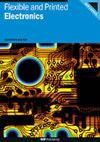紫外线辐照致电子皮肤用部分不溶性再生丝素膜
IF 3.2
4区 工程技术
Q3 MATERIALS SCIENCE, MULTIDISCIPLINARY
引用次数: 0
摘要
摘要再生丝素(RSF)膜被认为是生物相容性、柔性和可生物降解的电子皮肤(e-skin)设备的理想底物。然而,通过调整其二级结构来平衡RSF膜的柔韧性和溶解度仍然是一个很大的挑战。在此,将水解的RSF制备的薄膜暴露在254 nm紫外线(UV)光下,制备了用于应变传感电子皮肤的交联部分不溶于水的底物。通过在85°C下加热一定时间,制备了水解的低分子量RSF。用RSF水解液浇铸的膜能迅速完全溶解于水中。紫外线照射可诱导低分子量RSF发生交联形成不溶性物质,从而形成部分不溶性RSF膜。将银纳米线涂覆后,成功构建了基于uv辐射膜的电子皮肤应变传感器。该传感器具有响应时间快(2.01 s)、灵敏度高(在0% ~ 40%应变范围内GF = 1.03)、稳定性好等特点。该装置可以用一滴水紧紧附着在人体皮肤上。手指、手腕、肘部和膝盖的弯曲可以实时灵敏地检测到。将电子皮肤分别贴在脖子和脸颊上,也能感应到头部点头和嘴巴张开的动作。这项工作可能为制备可拉伸和可粘附的RSF薄膜提供了一种简便的方法,该薄膜可以作为可穿戴应用的低成本、可生物降解、直接接触皮肤传感器的理想衬底。本文章由计算机程序翻译,如有差异,请以英文原文为准。
Partially insoluble regenerated silk fibroin film induced by UV irradiation for electronic skins
Abstract The regenerated silk fibroin (RSF) film has been regarded as an ideal substrate for biocompatible, flexible, and biodegradable electronic skin (e-skin) devices. However, it is still a great challenge to balance the flexibility and solubility of the RSF film by adjusting its secondary structure. Herein, a film prepared with the hydrolyzed RSF was exposed to the 254 nm ultraviolet (UV) light to prepare a crosslinked and partially water-insoluble substrate for a strain-sensing e-skin. The hydrolyzed low-molecular-weight RSF was produced by heating the LiBr-silk fibroin solution at 85 °C for a certain duration. The film cast with the hydrolyzed RSF solution could be thoroughly dissolved in water rapidly. The UV irradiation could induce the crosslinking of the low-molecular-weight RSF to form insoluble substances, thus producing a partially insoluble RSF film. After silver nanowires painting, an e-skin strain sensor was successfully constructed based on the UV-irradiated film. The sensor shows a fast response time (2.01 s), high sensitivity (GF = 1.03 within 0%–40% strain range), and good stability. The device could be tightly attached to human skin with a drop of water. The finger, wrist, elbow, and knee bending could be sensitively detected in real-time. The head nodding and mouth opening could also be sensed by sticking the e-skin at the neck and cheek, respectively. This work may provide a facile way to prepare a stretchable and stickable RSF film, which could serve as an ideal substrate of low-cost, biodegradable, direct-to-skin sensors for wearable applications.
求助全文
通过发布文献求助,成功后即可免费获取论文全文。
去求助
来源期刊

Flexible and Printed Electronics
MATERIALS SCIENCE, MULTIDISCIPLINARY-
CiteScore
4.80
自引率
9.70%
发文量
101
期刊介绍:
Flexible and Printed Electronics is a multidisciplinary journal publishing cutting edge research articles on electronics that can be either flexible, plastic, stretchable, conformable or printed. Research related to electronic materials, manufacturing techniques, components or systems which meets any one (or more) of the above criteria is suitable for publication in the journal. Subjects included in the journal range from flexible materials and printing techniques, design or modelling of electrical systems and components, advanced fabrication methods and bioelectronics, to the properties of devices and end user applications.
 求助内容:
求助内容: 应助结果提醒方式:
应助结果提醒方式:


